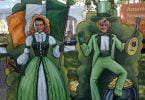
Italian fashioner designer Donatella Versace and Cardinal Gianfranco Ravasi, president of the Pontifical Council for Culture, arrive for a press presentation for the exhibit, “Heavenly Bodies: Fashion and the Catholic Imagination,” at Galleria Colonna in Rome Feb. 26. The Vatican is loaning forty vestments and sacred objects for an exhibit at the Metropolitan Museum of Art in New York from May 10-Oct. 8. (CNS photo/Paul Haring)
by Olivia Martin
I’ve been looking forward to the Met’s exhibition “Heavenly Bodies: Fashion and the Catholic Imagination” since I read an article the Catholic News Service wrote about it two months ago.
The article outlined the Vatican’s contribution to the exhibit, including papal vestments and accoutrements, and explained that the exhibit would also contain pieces of high-fashion clothing that were inspired by Catholic symbolism and art — a visual and tangible experience of the church’s influence on high-fashion and its imaginative designers through the centuries.
Who wouldn’t be excited about the possibilities to come from a collaboration among the Met, the Vatican, and Vogue, I thought. Donatella Versace, high-fashion designer, and CardinalGianfranco Ravasi, president of the Pontifical Counsel for Culture — what an incredible, unexpected combination.
It sounded like an opportunity.
The Met Gala was soon to follow on May 7, showcasing, according to Vogue, the “pinnacle of iconic style” in a fundraiser for the Metropolitan Museum of Art in New York. And this year’s theme was “The Catholic Imagination” in celebration of the exhibit and its debut.
As expected, the costumes of the stars indeed were everything from transcendent to edgy, delicate to shocking.
For some, the gowns of the night were a source of inspiration, but for others they were seen as blasphemous mockeries of the truth, and I’ve received many questions about the whole event.
Amidst the great variety of praises and backlashes concerning the event and now the exhibit as a whole, I found myself confronted by the media and friends mainly with two mindsets: the church has finally caught up with the world by realizing modernity’s standards are true or the world is staining the church with its evil and irreverence and should be ashamed.
In my education I’ve understood that in most cases, the truth tends to lie in the balance and is sometimes not what I immediately intuit.
Let me share an example.
During Lent I attended a retreat of sorts and had the opportunity to ask a priest friend of mine a question about authority. I asked him, “What does it mean when someone or something that once was an authority for me ceases to be so?” having in mind a community to which I belong.
He looked at me and responded with a quote from the Catholic French novelist Georges Bernanos’ “Dialogues of the Carmelites.”
The novel is staged in revolutionary France where a convent of nuns has been informed by the government that it is illegal to profess vows. The novices scoff at the law, but their mother superior, to their amazement, says they will observe it.
Paraphrasing her explanation, she says: It is not up to us to oppose injustice. It is up to us to suffer for it.
There’s hardly been a day that I haven’t thought about that statement. And while I don’t think it contains the totality of the response required in the face of the Met Gala, it’s true and is certainly a place to begin, capable of giving meaning to the offense some are experiencing.
Thanks to many great modern minds like St. John Paul the Great, Dostoyevsky, Pope Emeritus Benedict XVI and Servant of God Fr. Luigi Giussani, I’ve come to believe in the educative and saving power of beauty precisely because it points to the truth, who is Christ, who is ever-present and makes himself known in every moment of reality.
This includes the Met Gala.
Because of this fact which is the fact of the resurrection, it is also true that everything is an opportunity for Christ to enter into the life of men; everything is useful for him — the eternal creator — even the crosses on Kim Kardashian’s dress.
I’ve come to see the mix of fascinating, tacky and exquisite clothing worn at the Met Gala as a beautiful occasion, as an opportunity for Christ to be seen not because the attempt at beauty was perfect, but because it was honest.
Much like a man who only prays when he’s drunk, many people who live in a predominantly secular way were asked to use their imaginations to engage with Catholicism from where they were and in a manner familiar to them: through high-fashion.
And the Church, because of the reality of Christ, was and continues to be asked to recognize the beauty in that attempt and give praise to God.
Because you never know, God can make use of anything. Even Kim Kardashian’s dress.






